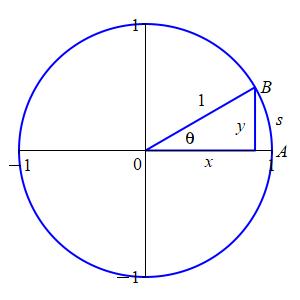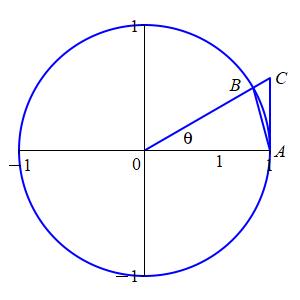7. Computing Limits
c. Sandwich Theorem
2. Sine and Cosine Limits
The most important application of the Sandwich Theorem is to prove the following four limits about \(\sin\) and \(\cos\). \[\begin{aligned} \lim_{\theta\to0}\sin\theta&=0 &\qquad&\lim_{\theta\to0}\cos\theta=1\\ \lim_{\theta\to0}\dfrac{\sin\theta}{\theta}&=1 &\qquad&\lim_{\theta\to0}\dfrac{1-\cos\theta}{\theta}=0 \end{aligned}\] The first two seem obvious since \[ \sin0=0 \qquad \cos0=1 \] However, in principle, the value of a function may or may not be the same as the limit. The formal proofs involve the Sandwich Theorem. (They do not need the precise definition of limits.)
\[ \lim_{\theta\to0}\sin\theta=0 \qquad\lim_{\theta\to0}\cos\theta=1 \]
Let's first assume \(\theta\gt0\). The diagram shows a unit circle
and a ray at an angle \(\theta\)
intersecting the circle at the point \(B=(\cos\theta,\sin\theta)\).
The circumference of the full circle is \(2\pi r=2\pi\).
The fraction of the circumference occupied by the arc \(\stackrel{\frown}{AB}\)
is \(\dfrac{\theta}{2\pi}\) (in radians). So the length of the arc is
\(s=\dfrac{\theta}{2\pi}2\pi=\theta\). The perpendicular
from \(B\) to the \(x\)-axis has length \(y=\sin\theta\) and since the
length of a perpendicular is shortest distance, we conclude
\[
0 \le \sin\theta \le s = \theta
\]
So \(\sin\theta\) is squeezed between \(0\) and \(\theta\). Since
\[
\lim_{\theta\to0^+}0=\lim_{\theta\to0^+}\theta=0
\]
we conclude \(\displaystyle \lim_{\theta\to0^+}\sin\theta=0\) also.

Now, let's assume \(\theta\lt0\). We let \(t=-\theta\) and use the fact that \(\sin\) is odd, to compute: \[ \lim_{\theta\to0^-}\sin\theta =\lim_{t\to0^+}\sin(-t) =-\lim_{t\to0^+}\sin(t) =0 \]
This limit does not need the Sandwich Theorem. We just use a trig identity
the Limit Laws and the previous limit.
\[\begin{aligned}
\lim_{\theta\to0}\cos\theta
&=\lim_{\theta\to0}\sqrt{1-\sin^2\theta} \\
&=\sqrt{\lim_{\theta\to0}\left(1-\sin^2\theta\right)} \\
&=\sqrt{1-\left(\lim_{\theta\to0}\sin\theta\right)^2} \\
&=\sqrt{1-(0)^2}=1 \\
\end{aligned}\]
\[ \lim_{\theta\to0}\dfrac{\sin\theta}{\theta}=1 \qquad\lim_{\theta\to0}\dfrac{1-\cos\theta}{\theta}=0 \]
The diagram shows a unit circle and a ray at an angle \(\theta\)
intersecting the circle at the point \(B=(\cos\theta,\sin\theta)\).
The area of the full circle is \(\text{Area}_\bigcirc=\pi r^2=\pi\).
The fraction of the area occupied by the sector \(\measuredangle OAB\)
is \(\dfrac{\theta}{2\pi}\) (in radians). So the area of the sector is
\[
\text{Area}_{\measuredangle OAB}=\dfrac{\theta}{2\pi}\pi=\dfrac{\theta}{2}
\]
This sector is sandwiched between two triangles. The smaller triangle is
\(\triangle OAB\) whose area is
\[
\text{Area}_{\triangle OAB}=\dfrac{1}{2}(1)\sin\theta
\]
The larger triangle is \(\triangle OAC\) whose area is
\[
\text{Area}_{\triangle OAC}=\dfrac{1}{2}(1)\tan\theta
\]

The three areas are related by: \[ \text{Area}_{\triangle OAB} \le \text{Area}_{\measuredangle OAB} \le \text{Area}_{\triangle OAC} \] \[ \dfrac{1}{2}\sin\theta \le \dfrac{\theta}{2} \le \dfrac{1}{2}\tan\theta \] The first inequality can be rearranged to say: \[ \dfrac{\sin\theta}{\theta} \le 1 \] The second inequality can be rearranged to say: \[ 1 \le \dfrac{\tan\theta}{\theta}=\dfrac{\sin\theta}{\theta\cos\theta} \] or \[ \cos\theta \le \dfrac{\sin\theta}{\theta} \] Together, they say \(\dfrac{\sin\theta}{\theta}\) is squeezed between \(\cos\theta\) and \(1\). Since \[ \lim_{\theta\to0}\cos\theta=\lim_{\theta\to0}1=1 \] we conclude \(\displaystyle \lim_{\theta\to0}\dfrac{\sin\theta}{\theta}=1\) also.
This limit does not need the Sandwich Theorem. We multiply by the conjugate,
use a trig identity and the previous limits.
\[\begin{aligned}
\lim_{\theta\to0}\dfrac{1-\cos\theta}{\theta}
&=\lim_{\theta\to0}\dfrac{(1-\cos\theta)}{\theta}\dfrac{(1+\cos\theta)}{(1+\cos\theta)} \\
&=\lim_{\theta\to0}\dfrac{(1-\cos^2\theta)}{\theta^2}\dfrac{\theta}{(1+\cos\theta)} \\
&=\lim_{\theta\to0}\dfrac{\sin^2\theta}{\theta^2}\dfrac{\theta}{(1+\cos\theta)} \\
&=\left(\lim_{\theta\to0}\dfrac{\sin\theta}{\theta}\right)^2
\lim_{\theta\to0}\dfrac{\theta}{1+\cos\theta} \\
&=(1)^2\left(\dfrac{0}{1+1}\right)=0
\end{aligned}\]
Compute \(\displaystyle \lim_{x\to0}\dfrac{2x+3x^2}{\sin x}\)
Divide the numerator and denominator by \(x\). Then use the Quotient Law and the limit \(\displaystyle \lim_{x\to0}\dfrac{\sin x}{x}=1\): (Note the variable does not matter.) \[\begin{aligned} \lim_{x\to0}&\dfrac{2x+3x^2}{\sin x} =\lim_{x\to0}\dfrac{2+3x}{\dfrac{\sin x}{x}} \\ &=\dfrac{\displaystyle \lim_{x\to0}(2+3x)}{\displaystyle \lim_{x\to0}\dfrac{\sin x}{x}} =\dfrac{2}{1}=2 \end{aligned}\]
Compute \(\displaystyle \lim_{\theta\to0}\dfrac{1-\cos\theta}{\theta^2}\).
Multiply numerator and denominator by the conjugate and use a trig identity.
\(\displaystyle \lim_{\theta\to0}\dfrac{1-\cos\theta}{\theta^2}=\dfrac{1}{2}\)
We multiply by the conjugate, use a trig identity and the previous limits. \[\begin{aligned} \lim_{\theta\to0}\dfrac{1-\cos\theta}{\theta^2} &=\lim_{\theta\to0}\dfrac{(1-\cos\theta)}{\theta^2}\dfrac{(1+\cos\theta)}{(1+\cos\theta)} \\ &=\lim_{\theta\to0}\dfrac{(1-\cos^2\theta)}{\theta^2}\dfrac{1}{(1+\cos\theta)} \\ &=\lim_{\theta\to0}\dfrac{\sin^2\theta}{\theta^2}\dfrac{1}{(1+\cos\theta)} \\ &=\left(\lim_{\theta\to0}\dfrac{\sin\theta}{\theta}\right)^2 \lim_{\theta\to0}\dfrac{1}{1+\cos\theta} \\ &=(1)^2\left(\dfrac{1}{1+1}\right)=\dfrac{1}{2} \end{aligned}\]
Heading
Placeholder text: Lorem ipsum Lorem ipsum Lorem ipsum Lorem ipsum Lorem ipsum Lorem ipsum Lorem ipsum Lorem ipsum Lorem ipsum Lorem ipsum Lorem ipsum Lorem ipsum Lorem ipsum Lorem ipsum Lorem ipsum Lorem ipsum Lorem ipsum Lorem ipsum Lorem ipsum Lorem ipsum Lorem ipsum Lorem ipsum Lorem ipsum Lorem ipsum Lorem ipsum